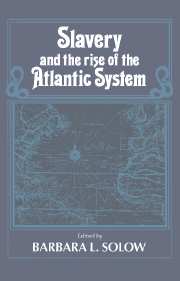Book contents
- Frontmatter
- Contents
- Preface
- List of contributors
- Introduction
- 1 Slavery and colonization
- 2 The Old World background of slavery in the Americas
- 3 Slavery and lagging capitalism in the Spanish and Portuguese American empires, 1492–1713
- 4 The Dutch and the making of the second Atlantic system
- 5 Precolonial western Africa and the Atlantic economy
- 6 A marginal institution on the margin of the Atlantic system: The Portuguese southern Atlantic slave trade in the eighteenth century
- 7 The apprenticeship of colonization
- 8 Exports and the growth of the British economy from the Glorious Revolution to the Peace of Amiens
- 9 The slave and colonial trade in France just before the Revolution
- 10 Slavery, trade, and economic growth in eighteenth-century New England
- 11 Economic aspects of the growth of slavery in the seventeenth-century Chesapeake
- 12 Credit in the slave trade and plantation economies
- Index
4 - The Dutch and the making of the second Atlantic system
Published online by Cambridge University Press: 20 October 2009
- Frontmatter
- Contents
- Preface
- List of contributors
- Introduction
- 1 Slavery and colonization
- 2 The Old World background of slavery in the Americas
- 3 Slavery and lagging capitalism in the Spanish and Portuguese American empires, 1492–1713
- 4 The Dutch and the making of the second Atlantic system
- 5 Precolonial western Africa and the Atlantic economy
- 6 A marginal institution on the margin of the Atlantic system: The Portuguese southern Atlantic slave trade in the eighteenth century
- 7 The apprenticeship of colonization
- 8 Exports and the growth of the British economy from the Glorious Revolution to the Peace of Amiens
- 9 The slave and colonial trade in France just before the Revolution
- 10 Slavery, trade, and economic growth in eighteenth-century New England
- 11 Economic aspects of the growth of slavery in the seventeenth-century Chesapeake
- 12 Credit in the slave trade and plantation economies
- Index
Summary
“IN matters of commerce the trouble with the Dutch is giving too little and asking too much,” a British foreign secretary once is supposed to have remarked. Whatever the value of such political poetry, the contents of this rhyme apply very neatly to the Dutch expansion in the Atlantic. By giving little and asking much, the Dutch were forced to exploit the Atlantic in combination with many other nations. First, the Dutch turned to the Spanish and the Portuguese Atlantic empires and siphoned off part of their trade and produce. Later they turned to the British and the French and did the same. This role of intermediary gave the Dutch an important position in shaping the conditions in the Atlantic that went far beyond the economic importance of their own relatively modestly sized possessions.
The impact of the Dutch can be fully appreciated only after contrasting the nature of the Portuguese and Spanish expansion in the Atlantic with that of the countries of northwestern Europe during the seventeenth and eighteenth centuries. The differences between the first and second Atlantic systems are discussed in part I of this chapter. The role of the Dutch in the creation of the second Atlantic system during the second and third quarters of the seventeenth century is outlined in part II. Part III provides a survey of the Dutch involvement in the slave trade and the use of slave labor in the Dutch colonial economy.
- Type
- Chapter
- Information
- Slavery and the Rise of the Atlantic System , pp. 75 - 96Publisher: Cambridge University PressPrint publication year: 1991
- 13
- Cited by

